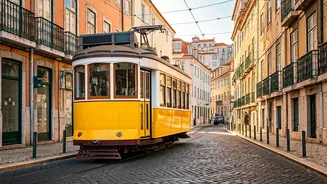City's Postcard Views
Start your Lisbon journey by embracing the city's breathtaking views. Admire the stunning facades of the Manueline UNESCO World Heritage sites, such as
Mosteiro dos Jerónimos and Torre de Belém. Capture photos of the iconic black-and-white _calçada portuguesa_ from viewpoints in Graça and Alfama. Join the sunset-seeking crowd at Cais das Colunas. Keep in mind that lines for popular spots and historic trams can be long, so consider visiting during off-peak hours for a more enjoyable experience.
Mingle with Locals
Experience the authentic side of Lisbon by mingling with locals during lunchtime. From 1 to 3 pm on weekdays, traditional restaurants and _tascas_ buzz with activity as local workers enjoy their breaks. Despite the rush, _lisboetas_ prefer to sit and savor their meals. You'll find affordable, homemade-style dishes in fixed-price _pratos do dia_. Some recommended spots include , , and . Consider discovering Portugal's passion for salted codfish at , learning how it became a staple dish of local cuisine.
Learn of Carnation Revolution
Delve into Portugal's past with a visit to Museu do Aljube, housed in a former political prison. The museum addresses the country's recent history of oppression, censorship, and government-approved social norms. The Estado Novo, a totalitarian regime, ended with a peaceful military coup on April 25, 1974. At Largo do Carmo, scan the QR code to see archive footage and reenactments of the day's events. This offers a poignant insight into Portugal's transformation from a monarchy to a republic in 1910.
Shop at Historic Stores
Support local businesses and take home unique souvenirs by shopping at 'Loja com História' locations. These shops, marked by distinctive architecture, are part of Lisbon's history. Find custom-made hats from and tailored gloves from ; browse books and merchandise from , the world’s oldest bookstore; and savor canned fish from . This program, initiated by the Lisbon City Council in 2015, allows you to find unique souvenirs and support local businesses.
Art's Diverse Collections
Immerse yourself in Lisbon's diverse art scene. Visit MAAT Gallery and MAAT Central for experimental and contemporary art. Explore classic and modern masterpieces at Museu Nacional de Arte Antiga, Museu Calouste Gulbenkian, and Centro de Arte Moderna. Discover the works of Portuguese painter Helena Vieira da Silva (1908–92) and her husband Árpád Szenes at the Fundação Arpad Szenes-Vieira da Silva, housed in a converted silk factory in Amoreiras. The art district of Marvila features the refurbished Abel Pereira da Fonseca wine warehouses, now a cultural hub with art shops and galleries. Emerging artists and performers showcase their work around Marquês de Pombal in unconventional spaces like (a deactivated, underground public bathroom) and (the gardens at the former psychiatric hospital).
Unearth Lisbon's Past
Uncover the layers of Lisbon's past, buried beneath the rubble of the 1755 earthquake. Construction sites in the downtown area often turn into archaeological excavations, revealing artifacts. Visit Núcleo Arqueológico da Rua dos Correeiros beneath a bank's headquarters. The first floor of Fundação José Saramago, and the lobby of hotel also offer insights into the city's history. To discover more, take a trip to Cascais and explore the nearby ruins of a Roman housing complex.
Listen to Fado Music
Experience the soulful sounds of fado, often performed in traditional Portuguese restaurants known as _casas de fado_ or more casual _tascas_. Alfama, a historic neighborhood, has a high concentration of fado venues. Some venues are , , and . You may focus solely on the musical experience, leaving the dinner option, with one-hour concerts in three venues. Listen to the music at bar Pavilhão Chinês (Thursdays), underground reservoir Reservatório da Patriarcal (Fridays and Saturdays), and concept gallery EmbaiXada (Sundays). Lisbon-based Amália Rodrigues (1920–99), the most famous _fadista_ (fado singer) in Portugal, helped bring international fame to the genre.
Buildings Survived Earthquake
Discover the buildings that survived the devastating 1755 earthquake. While much of Lisbon's historic architecture was lost, some structures remain. Explore the house at 20 Rua dos Cegos in Alfama and Convento dos Cardaes, a 17th-century convent in Bairro Alto. These enduring structures stand as testaments to the city's resilience. The earthquake killed thousands, destroyed buildings, and redefined Lisbon's downtown area. Exploring these areas offers a look into Lisbon's historic past.
Movie at Neighborhood Cinema
Enjoy a movie at one of Lisbon's neighborhood cinemas. While shopping malls offer multiple-screen entertainment, two small cinemas continue to thrive, featuring festivals and recently released independent films: , a 50-year-old institution, and , a renovated cinema that opened in the early 1900s. In the summer (June to September), catch outdoor screenings at Carmo Rooftop (), Igreja da Graça (), or Cine-Gastro-Bar 39 Degraus (). These cinemas offer an intimate and unique cinematic experience, showcasing films beyond mainstream options.










